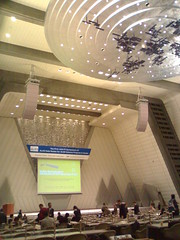Much has been made of the potential sequester the U.S. faces this New Years’ Eve, which the masses have affectionately labeled the “fiscal cliff.” Well, with the possibility of large impacts to the average person and small business, rightly so. However, what has not been rightly emphasized, in our opinion, is the potentially devastating effects this cliff could have on our nation’s environmental sector. The cliff would lead to higher taxes and governmental budget cuts in the defense department, yes. But what is less well-known is that the governmental cuts will also most likely include environmental victims.
For one, the energy industry could be significantly hurt, both at governmental and private sector levels. Solar energy contractors who rely on receiving current 1603 cash grants for installation projects will not see those cash grants should the US see the cliff. This could strongly hinder the financing of solar energy projects, depleting a relatively small but significant portion of the necessary cash for such projects.
Moreover, the cliff would trigger a $148 million retraction of funds from the US Energy Efficiency and Renewable Energy program. To help put this into perspective, this loss is the equivalent of cutting the US Department of Energy’s solar energy program completely in half. These cuts to agencies like the Department of Energy threaten not only a decrease in energy development, but also a decrease in energy usage, as programs would lose funding for research and loans used now for innovation projects. The future would be increasingly questionable.
A second instance would have harmful effects for the US National Parks, National Forests, wildlife refuges, and other public lands. For instance, the 258,000 jobs scattered among US National Parks and the 35,000 jobs among wildlife refuges could be jeopardized by the expected cuts in science and law enforcement positions at these establishments. Similarly, the 2 million plus jobs within the Bureau of Land Management, which oversees the US National Forests could also find themselves in limbo, as awaited budget cuts loom large. The National Oceanic and Atmospheric Association, which employs 66 million scientists, educators, researchers, and technicians, among others, could see devastating effects, as well.
As the list goes on, the bottom line remains ever evident. In cutting governmental agencies’ budgets, the environmental agencies will surely be among those who see drastic cuts. Further, those cuts could prove disastrous, and at the very least, detrimental to the US’s management, protection, and research of the environment. There are millions of jobs at risk, in addition to the health and lives of the organisms living among the zones over which these agencies keep watch.
Overall, based on the observations and predictions surrounding the seemingly imminent sequester our government currently wrestles, there could be hampering effects on government agencies who will see severe cuts, US citizens who will see layoffs, and wildlife who will see the harmful effects of increased neglect. So God Speed to our government representatives, in hopes that their efforts add up to a reasonable solution that can avoid harmful cuts to the essential beings of such agencies, people, and wildlife.
[polldaddy poll=6799106]
Sources for More Reading:
http://www.greentechmedia.com/articles/read/guest-post-what-would-the-fiscal-cliff-mean-for-the-u.s.-solar-market
http://www.governing.com/news/state/gov-fiscal-cliff-full-coverage.html
http://www.forbes.com/sites/eco-nomics/2012/11/15/the-fiscal-cliff-and-the-environment/
http://blog.cleanwateraction.org/2012/12/06/dont-let-the-fiscal-cliff-devastate-our-environment/








